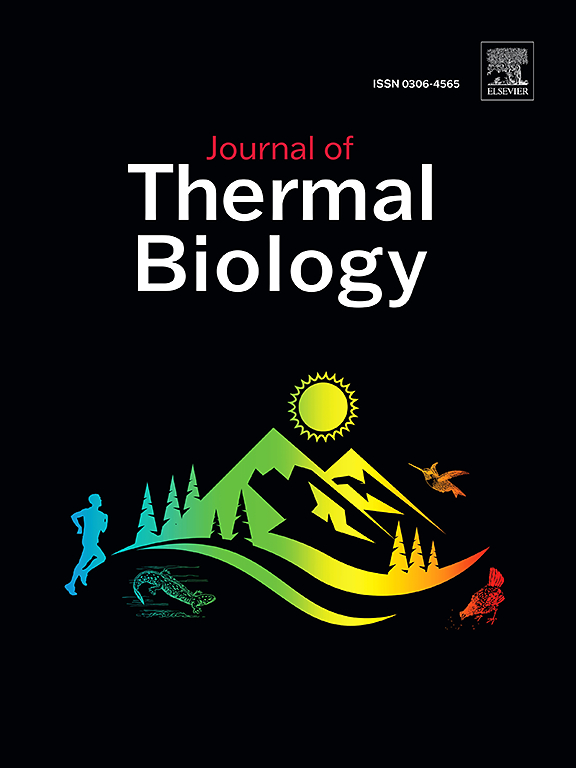学龄儿童与成人睡眠发作潜伏期床上小气候与热舒适差异的研究。
IF 2.9
2区 生物学
Q2 BIOLOGY
引用次数: 0
摘要
睡眠开始潜伏期(SOL)的热舒适显著影响整体睡眠质量。以往的研究大多侧重于实际睡眠时的热舒适,而本研究考虑到学龄儿童和成人在不同睡眠热条件下不同的生理特征和热偏好,旨在研究和比较学龄儿童和成人睡眠时床上小气候和热舒适。14名学龄儿童和14名成人分别在冬季条件下(8°C和11°C)和过渡条件下(21°C和24°C)进行了两项实验。每次实验持续60 min,持续监测皮肤温度和床上小气候。每次实验结束后收集热感觉主观评价。实验结果表明,学龄儿童和成人受试者之间的皮肤温度差异在冬季条件下更为明显,这强调了在设计最佳睡眠热环境时考虑年龄相关差异的重要性,特别是在寒冷的月份。学龄儿童的Tsk舒适范围确定为34.4-35.4°C,而成人的舒适范围略窄,为34.3-35.0°C。此外,学龄儿童的舒适床温范围在30.8至33.8°C之间,而成人的舒适床温范围为31.0至33.2°C。此外,观察到睡眠环境下Tsk的舒适范围比白天活跃环境高约0.4-1.3°C。这些发现提供了有价值的见解,可以为有效的热环境设计提供信息,旨在提高儿童和成人的SOL,从而有助于降低经济成本,同时提高能源效率。本文章由计算机程序翻译,如有差异,请以英文原文为准。
Investigation of the differences in bed microclimate and thermal comfort between school-aged children and adults during sleep onset latency
The thermal comfort experienced during sleep onset latency (SOL) significantly influences overall sleep quality. While most previous studies have primarily focused on thermal comfort during actual sleep, this study aims to investigate and compare the bed microclimate and thermal comfort during SOL in school-aged children and adults, taking into account their differing physiological characteristics and thermal preferences under various sleep thermal conditions. Fourteen school-aged children and fourteen adults participated in two experiments conducted under winter conditions (8 °C and 11 °C), as well as two experiments under transitional conditions (21 °C and 24 °C). Each experiment lasted 60 min, with continuous monitoring of skin temperatures and bed microclimate throughout the duration. Subjective assessments of thermal perception were collected after each experiment. The experimental results indicate that the difference in skin temperature (Tsk) between school-aged children and adult subjects is more pronounced under winter conditions, underscoring the importance of considering age-related differences when designing optimal sleep thermal environments, particularly during colder months. The comfortable range for Tsk among school-aged children is identified as 34.4–35.4 °C, while for adults it is slightly narrower at 34.3–35.0 °C. Additionally, the comfortable range for bed temperature (Tbed) is found to be between 30.8 and 33.8 °C for school-aged children compared to a range of 31.0–33.2 °C for adults. Furthermore, it was observed that the comfort range of Tsk is approximately 0.4–1.3 °C higher in the sleep environment than in the active daytime environment. These findings provide valuable insights that can inform the design of effective thermal environments aimed at enhancing SOL in both children and adults, thereby contributing to reduced economic costs while improving energy efficiency.
求助全文
通过发布文献求助,成功后即可免费获取论文全文。
去求助
来源期刊

Journal of thermal biology
生物-动物学
CiteScore
5.30
自引率
7.40%
发文量
196
审稿时长
14.5 weeks
期刊介绍:
The Journal of Thermal Biology publishes articles that advance our knowledge on the ways and mechanisms through which temperature affects man and animals. This includes studies of their responses to these effects and on the ecological consequences. Directly relevant to this theme are:
• The mechanisms of thermal limitation, heat and cold injury, and the resistance of organisms to extremes of temperature
• The mechanisms involved in acclimation, acclimatization and evolutionary adaptation to temperature
• Mechanisms underlying the patterns of hibernation, torpor, dormancy, aestivation and diapause
• Effects of temperature on reproduction and development, growth, ageing and life-span
• Studies on modelling heat transfer between organisms and their environment
• The contributions of temperature to effects of climate change on animal species and man
• Studies of conservation biology and physiology related to temperature
• Behavioural and physiological regulation of body temperature including its pathophysiology and fever
• Medical applications of hypo- and hyperthermia
Article types:
• Original articles
• Review articles
 求助内容:
求助内容: 应助结果提醒方式:
应助结果提醒方式:


